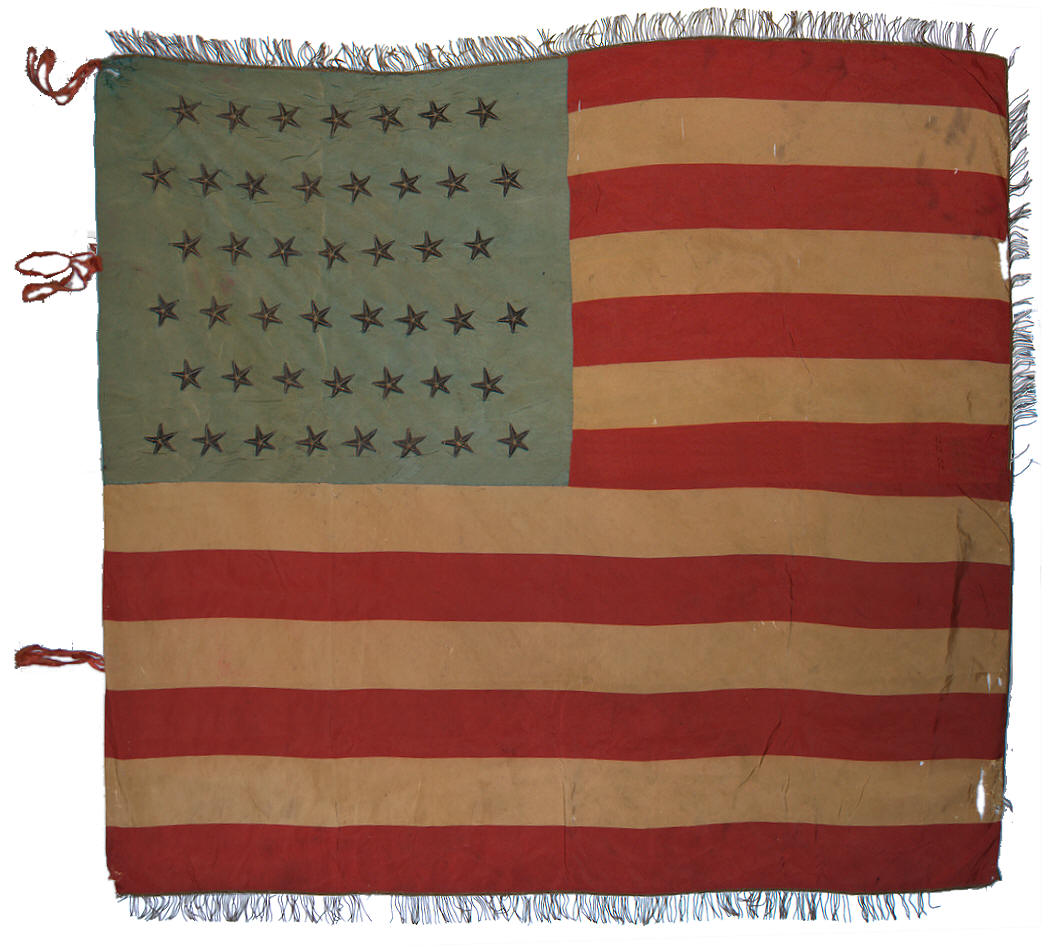
Regimental Battle Flags
are exceptionally rare, and their unique construction
makes them readily recognizable, regardless of the era
of the flag. Regimental flags from the Civil War,
Spanish American War, World War I, World War II, and
even later conflicts, are characterized by their large,
nearly square proportions. Other characteristics,
such as the presence of fringe, construction from
expensive materials such as silk and sometimes the
presence of ties along the hoist, are all attributes
which point to a military grade battle flag, rather than
a flag made for common commercial use. This flag
has all of those attributes, and thus I'm confident that
it was in fact made for military use, most likely as a
Regimental Color for a regiment of the period of
1896-1908, which spans the Spanish American War.
The flag
has one of the most spectacular and unique star cantons
I have ever encountered on a flag, The raised
embroidered stars are
constructed of a formed inner core and metallic threads that
today are nearly blue in color. The bullion fringe around the border of the flag
is now dark, but with golden coloration.
Although I'm uncertain of the precise composition of the
metals, the materials most likely consist in large part of
silver, and possibly a small amount of gold, though its
bluish coloration is unusual. The
flag features 45 stars on each side, and the stars
themselves are remarkably heavy and thick.
 The
silk of the flag has survived in excellent condition
compared to other silk flags of the period. There
is minimal splitting, but in general it's apparent the
flag was well kept and generally undisturbed over the
past 100 years. The fly end of the flag shows
signs of wear, indicating that the flag was flown, with
the bottom right corner of the flag missing most of its
bullion fringe. The blue of the canton has faded to
a beautiful gray-green-blue color, which enhances the
unique color of the stars and is striking next to the
ruby red and beige stripes. Although two of the
ties along the hoist are missing, three are present, and
a small tab of red, white and blue silk is present where
one of the ties used to be, indicating that perhaps the
original ties of the flag were red white and blue, and
were then later replaced by the current ties.
Repairs where the ties attach to the flag are evident,
evidence of the care taken by those who carried it in
the field. The
silk of the flag has survived in excellent condition
compared to other silk flags of the period. There
is minimal splitting, but in general it's apparent the
flag was well kept and generally undisturbed over the
past 100 years. The fly end of the flag shows
signs of wear, indicating that the flag was flown, with
the bottom right corner of the flag missing most of its
bullion fringe. The blue of the canton has faded to
a beautiful gray-green-blue color, which enhances the
unique color of the stars and is striking next to the
ruby red and beige stripes. Although two of the
ties along the hoist are missing, three are present, and
a small tab of red, white and blue silk is present where
one of the ties used to be, indicating that perhaps the
original ties of the flag were red white and blue, and
were then later replaced by the current ties.
Repairs where the ties attach to the flag are evident,
evidence of the care taken by those who carried it in
the field. |

